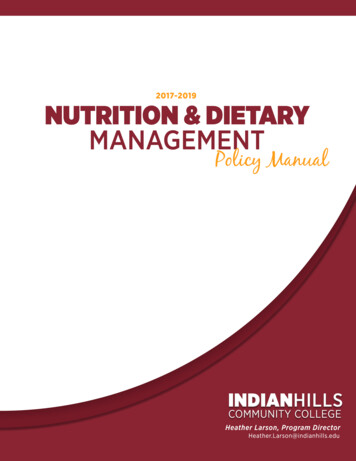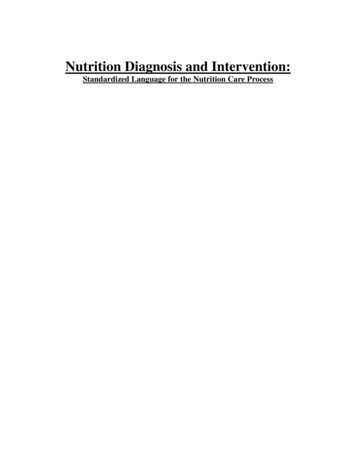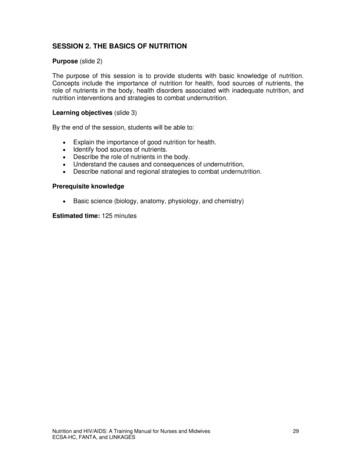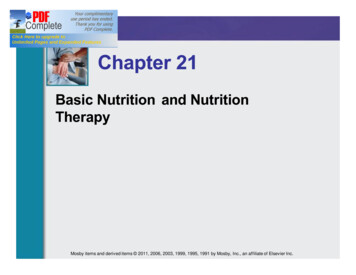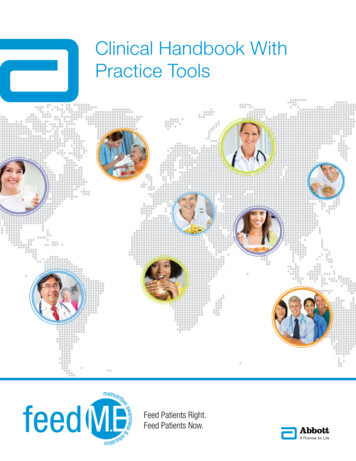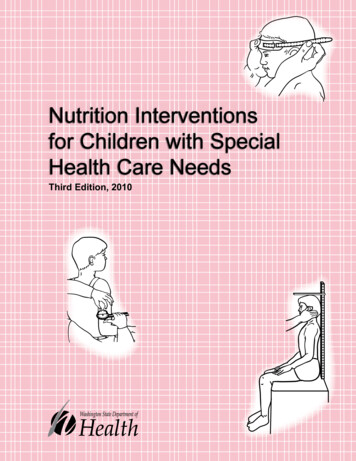
Transcription
Nutrition Interventionsfor Children with SpecialHealth Care NeedsThird Edition, 2010
Nutrition Interventions for Childrenwith Special Health Care Needs3rd edition, 2010DOH 961-158 April 2010To order this report, please visit the Washington State Department of PrintingFulfillment efault.aspFor persons with disabilities, this document is available on request in otherformats. To submit a request, please call 1-800-525-0127(TDD/TTY 1-800-833-6388).Mary SeleckySecretary of HealthNutrition Interventions for Children With Special Health Care Needs
Nutrition Interventions for Children With Special Health Care Needs
EditorsYuchi Yang, MS, RD, CDNutrition ConsultantChildren with Special Health Care Needs ProgramWashington State Department of HealthOlympia, WashingtonBetty Lucas, MPH, RD, CDNutritionistCenter on Human Development and DisabilityUniversity of WashingtonSeattle, WashingtonSharon Feucht, MA, RD, CDNutritionistCenter on Human Development and DisabilityUniversity of WashingtonSeattle, WashingtonAuthorsLaili Abd Latif, MS, RD, CDNutritionist, Benton Franklin Health District, Kennewick, WashingtonLori S. Brizee MS, RD, CSP, LDCentral Oregon Nutrition Consultants, Bend, OregonSusan Casey, RD, CDClinical Dietitian, Seattle Children’s Hospital, Seattle, WashingtonElaine Cumbie, MA, RD, CD, CDEClinical Dietitian, Seattle Children’s Hospital, Seattle, WashingtonSharon Feucht, MA, RD, CDNutritionist, Center on Human Development and Disability, University ofWashington, Seattle, WashingtonRobin Glass, MS, OTR, IBCLCOccupational Therapist, Seattle Children’s Hospital, Seattle, WashingtonKathryn L. Hunt, RD, CDClinical Dietitian, Seattle Children’s Hospital, Seattle, WashingtonNancy James, RD, CSP, CDClinical Dietitian, Sacred Heart Children’s Hospital, Spokane, WashingtonKelly A. Johnson, Ph.D.Clinical Psychologist, UW Autism Center, Center on Human Development &Disability, University of Washington, Seattle, WashingtonNaomi Katsh, MDPediatrician, Everett, WashingtonNutrition Interventions for Children With Special Health Care Needs
Kay Kopp, OTR/LOccupational Therapist, Center on Human Development and Disability,University of Washington, Seattle, WashingtonBetty Lucas, MPH, RD, CDNutritionist, Center on Human Development and Disability, University ofWashington, Seattle, WashingtonMelissa Mortensen, MS, RD, CSP, CDClinical Dietitian, Seattle Children’s Hospital, Seattle, WashingtonBeth Ogata, MS, RD, CSP, CDNutritionist, Center on Human Development and Disability, University ofWashington, Seattle, WashingtonDonna Parsons, MS, RDNutritionist, Office of the Superintendent of Public Instruction, Olympia,WashingtonAnnette Pederson, MS, RD, CDNutrition Support Dietitian, LifeCare Solutions, Richland, WashingtonPeggy Solan, RD, CDClinical Dietitian, Seattle Children’s Hospital, Seattle, WashingtonRoseann Torkelson, MS, RD, CDNutritionist, Center on Human Development and Disability, University ofWashington, Seattle, WashingtonCristine Trahms, MS, RD, CD, FADASenior Lecturer, Division of Biochemical Genetics, Department of Pediatrics,University of Washington, Seattle, WashingtonKathleen Washington, PT, PhDPhysical Therapist, Center on Human Development and Disability, Universityof Washington, Seattle, WashingtonLynn Wolf, MOT, OTR, IBCLCOccupational Therapist, Seattle Children’s Hospital, Seattle, WashingtonJoan Zerzan, MS, RD, CDClinical Dietitian, University of Washington Medical Center, Seattle,WashingtonAdvisory Committee (original edition)Lori Brizee, MS, RD, CSP, CDLisa Campo, MPH, RD, CD (deceased)Sharon Feucht, MA, RD, CDBetty Lucas, MPH, RD, CDMaria Nardella, MA, RD, CDBeth Ogata, MS, RD, CSP, CDNutrition Interventions for Children With Special Health Care Needs
ContentsAcknowledgements . . . . . . . . . . . . . . . . . . . . . . . . . . . . . . . . . . . . . . . . . . xiIntroduction . . . . . . . . . . . . . . . . . . . . . . . . . . . . . . . . . . . . . . . . . . . . . . . xiiiSection 1: Determination of Nutrition StatusChapter 1Nutrition Screening and Assessment . . . . . . . . . . . . . . . . . . . . . . . 1Chapter 2Anthropometrics . . . . . . . . . . . . . . . . . . . . . . . . . . . . . . . . . . . . 13Chapter 3Physical Activity . . . . . . . . . . . . . . . . . . . . . . . . . . . . . . . . . . . . 37Section 2: Problem-Based Nutrition InterventionsChapter 4Breastfeeding . . . . . . . . . . . . . . . . . . . . . . . . . . . . . . . . . . . . . 51Chapter 5Medication-Nutrient Interactions . . . . . . . . . . . . . . . . . . . . . . . . . 59Chapter 6Nutrition Interventions for Constipation . . . . . . . . . . . . . . . . . . . . 71Chapter 7Nutrition Interventions for Diarrhea . . . . . . . . . . . . . . . . . . . . . . 81Chapter 8Oral-Motor Feeding Problems . . . . . . . . . . . . . . . . . . . . . . . . . . . 93Chapter 9Behavior Issues Related to Feeding . . . . . . . . . . . . . . . . . . . . . . 101Chapter 10 Enteral Feeding (Tube Feeding). . . . . . . . . . . . . . . . . . . . . . . . . 121Chapter 11 Community Monitoring of the Patient on Home ParenteralNutrition . . . . . . . . . . . . . . . . . . . . . . . . . . . . . . . . . . . . . . . . 129Chapter 12 Accommodating Special Dietary Needs in the School System . . . . 137Section 3: Condition-Specific Nutrition InterventionsChapter 13 Nutrition Interventions for Overweight and Obesity . . . . . . . . . . . 143Chapter 14 Nutrition Interventions for Failure to Thrive . . . . . . . . . . . . . . . . 149Chapter 15 Nutrition Interventions for the Premature Infant After Discharge . 165Chapter 16 Nutrition Interventions for Respiratory Diseases . . . . . . . . . . . . . 177Chapter 17 Nutrition Interventions for Cystic Fibrosis . . . . . . . . . . . . . . . . . 191Chapter 18 Nutrition Interventions for Congenital Heart Disease . . . . . . . . . . 203Chapter 19 Nutrition Interventions for Chronic Renal Failure . . . . . . . . . . . . . 215Chapter 20 Nutrition Interventions for Short Bowel Syndrome . . . . . . . . . . . 227Chapter 21 Nutrition Interventions for Metabolic Disorders . . . . . . . . . . . . . . 237Chapter 22 Ketogenic Diet for Seizure Disorders . . . . . . . . . . . . . . . . . . . . . 247Chapter 23Nutrition Interventions for Autism Spectrum Disorders . . . . . . . . .263Nutrition Interventions for Children With Special Health Care Needs
AppendicesAppendix ASample Screening Forms . . . . . . . . . . . . . . . . . . . . . . . . . . . . .275Appendix BSources of Anthropometric Equipment . . . . . . . . . . . . . . . . . . . .279Appendix CHead Circumference (Nellhaus) – Boys . . . . . . . . . . . . . . . . . . . .281Head Circumference (Nellhaus) – GirlsAppendix DIncremental Growth Charts – Boys . . . . . . . . . . . . . . . . . . . . . .283Incremental Growth Charts – GirlsAppendix EParent-Specific Adjustment for Evaluation of Length andStature – Boys . . . . . . . . . . . . . . . . . . . . . . . . . . . . . . . . . . . .291Parent-Specific Adjustment for Evaluation of Length andStature – GirlsAppendix FPercentiles for Triceps Skinfold . . . . . . . . . . . . . . . . . . . . . . . . .299Percentiles of Upper Arm CircumferencePercentiles for Estimates of Upper Arm Fat and Upper ArmMuscle AreaAppendix GPhysical Growth in Males with Achondroplasia . . . . . . . . . . . . . . .303Physical Growth in Females with AchondroplasiaAppendix HGrowth References for Children with Quadriplegic CerebralPalsy – Boys . . . . . . . . . . . . . . . . . . . . . . . . . . . . . . . . . . . . . .311Growth References for Children with Quadriplegic CerebralPalsy – GirlsAppendix IBoys with Down Syndrome, Physical Growth: 1 to 36 Months . . . .319Girls with Down Syndrome, Physical Growth: 1 to 36 MonthsBoys with Down Syndrome, Physical Growth: 2 to 18 YearsGirls with Down Syndrome, Physical Growth: 2 to 18 YearsAppendix JIHDP Growth Percentiles: LBW Premature Boys . . . . . . . . . . . . . .327IHDP Growth Percentiles: LBW Premature GirlsIHDP Growth Percentiles: VLBW Premature BoysIHDP Growth Percentiles: VLBW Premature GirlsAppendix KPrader Willi Syndrome – Stature: Males 3 to 25 Years . . . . . . . . .335Prader Willi Syndrome – Stature: Females 3 to 25 YearsAppendix LGirls with Turner Syndrome: Physical Growth 2 to 19 Years . . . . .339Appendix MWilliams Syndrome – Stature, Males . . . . . . . . . . . . . . . . . . . . .341Williams Syndrome – Weight, MalesWilliams Syndrome – Stature, FemalesWilliams Syndrome – Weight, FemalesNutrition Interventions for Children With Special Health Care Needs
Appendix NTechnical Aspects of Enteral Feeding . . . . . . . . . . . . . . . . . . . . .345Appendix OTechnical Aspects of Parenteral Nutrition. . . . . . . . . . . . . . . . . . .369Appendix PDiet Order for Meals at School, Sample Forms . . . . . . . . . . . . . . .375Appendix QIEP Nutrition Related Goals and Objectives . . . . . . . . . . . . . . . . .377Appendix RTable of Selected Disorders Affecting Children with SpecialHealth Care Needs . . . . . . . . . . . . . . . . . . . . . . . . . . . . . . . . . .379Appendix SCommercial Nutrition Products . . . . . . . . . . . . . . . . . . . . . . . . .385Appendix TIncreasing Energy Density of Infant Formula . . . . . . . . . . . . . . . .397Appendix U Nutrition Resources for Children with Special Needs . . . . . . . . . . . 403Glossary . . . . . . . . . . . . . . . . . . . . . . . . . . . . . . . . . . . . . . . . . . . . . . . . . . 407Index. . . . . . . . . . . . . . . . . . . . . . . . . . . . . . . . . . . . . . . . . . . . . . . . . . . . . 415Nutrition Interventions for Children With Special Health Care Needs
Nutrition Interventions for Children With Special Health Care Needs
AcknowledgementsThere are several key groups who made this third edition of the NutritionInterventions for Children with Special Health Care Needs possible.We would like to thank the authors who contributed their time and expertise toupdate the information and references. We offer our deepest appreciation for thecontribution of editors who have spent hours attending to the many details. Thanksalso to registered dietitians who have reviewed and provided comments on thisedition. We would also like to extend our appreciation to registered dietitians andothers who worked on the first and second editions.The CSHCN Program deserves acknowledgement for supporting staff that hadcontinual involvement in this project. The Washington WIC Program provided thefunding for closure on the project, including the final printing and CDs. WIC mustalso be acknowledged for its key role in the distribution of the resource to WICClinics throughout Washington State and for its consistent integration of informationfrom this resource into statewide training plans and curriculum for community-basedWIC nutritionists.This project was undertaken to meet the needs of nutritionists serving children withspecial health care needs in Washington, but we know there will be interest fromothers around the country. We are happy to add this book to the national pool ofresources for providers working with children with special health care needs andhope that others continue to do the same.Lastly, we acknowledge the users of this resource who will have a critical role inimplementing the nutrition intervention strategies outlined in the book to improvethe nutritional status of children with special health care needs. We would also like toextend our appreciation to our colleagues from other disciplines and caregivers withwhom we work as partners to help children with special health care needs reach theirfull potential.Nutrition Interventions for Children With Special Health Care Needsi
iiNutrition Interventions for Children With Special Health Care Needs
IntroductionMaria NardellaUpdated by Yuchi YangBackgroundThe original edition of Nutrition Guidelines for Children with Disabilities and ChronicIllnesses was published in 1989 in response to an assessment of needs for nutritionservices in Neurodevelopmental Centers and local health departments throughout thestate of Washington.The primary users in Washington were members of a statewide network of registereddietitians/nutritionists who provide services to children with special health careneeds. In 1996, this group was surveyed to determine how useful the book still wasas a resource and if there was enough interest and need to warrant a revision. Theoverwhelming results were to initiate a revision process.An Advisory Committee was formed and a part time Coordinator/Editor was hired torevise and expand the 1989 version. It was intended to be a contribution to existingtools and nutrition resources for dietetic practitioners that serve to guide or definethe provision of nutrition care for children with special health care needs in multipleservice settings. It was an expensive endeavor even though hundreds of hours ofwork were generously donated by the 30 unpaid authors of the various chapters andtheir employers. It took four years to complete (2001), and the name of the newpublication was changed to “Nutrition Intervention for Children with Special HealthCare Needs.” In 2002, a second edition and second printing was done which includedminor corrections and additions.New EditionFor the past few years, the CSHCN Program has received numerous requests fora new edition. The work on the third edition was initiated in 2008. Again, manyauthors, editors and reviewers have come forward and contributed their expertiseand donated hundreds of unpaid hours for the completion of the third edition.This edition includes three new chapters, which makes the publication morecomprehensive. These chapters include breastfeeding, physical activity, and autismspectrum disorders.Nutrition Interventions for Children With Special Health Care Needsiii
Population“Children with special health care needs” refers to children with or at increased riskfor a broad range of chronic illnesses or disabling conditions who require interventionbeyond basic, routine, pediatric care.Organization of the BookThe book is divided into three sections.Section 1 “Determination of Nutritional Status” outlines the recommendedprocedures for nutrition screening, and assessment; and addresses the prerequisitesteps to take in the development of a nutrition intervention care plan.Section 2 “Problem-Based Nutrition Interventions” addresses the nutrition-relatedproblems that are more common across a wide range of diagnoses.Section 3 “Condition-Specific Nutrition Interventions” addresses nutritionmanagement related to specific diseases and disorders that have strong nutritioncomponents.Intervention strategies with evaluation/outcomes are presented in each chapterbased on the following screening and assessment components: Anthropometric Biochemical Clinical/Medical history Dietary Feeding Socioeconomic characteristicsEach chapter contains a “Nutrition Interventions” table that addresses steps to takein assessment, appropriate interventions to consider, and achievable outcomes.Some material is intentionally repeated in the summary table for each chapter,recognizing that users of this book may want to utilize individual chapters as “freestanding” documents. This is also why references are included with each chapterversus one list at the end of the book.Lastly, there is an extensive Appendix that provides more detailed supportiveinformation for the topics presented in the earlier sections and includes many usefultools.ivNutrition Interventions for Children With Special Health Care Needs
It is hoped that this book will enhance the development of the following skills: Comprehensive nutrition assessment Nutrition assessment of abnormal growth patterns Advanced nutrition assessment and counseling for special diets Appropriate uses of special formulas Interpretation and application of objective data Development of nutrition intervention strategies to produce outcomes Participation as a team member to provide interdisciplinary careMost nutrition and feeding problems of children with special health care needs can beimproved or controlled, but often are not totally resolved. These children will requireongoing and periodic nutrition assessment and intervention. This book is a resourcethat will be needed time and again.Nutrition Interventions for Children With Special Health Care Needsv
viNutrition Interventions for Children With Special Health Care Needs
Section 1 - Determination of Nutrition StatusChapter 1Nutrition Screening and assessmentJanet Gilliam, MS, RD, CD and Sandi Laney, RD, CDUpdated by Roseann Torkelson, MS, RD, CDNutrition disorders and compromised nutritional status are common among childrenwith special health care needs. As many as 40% of infants and children with specialhealth care needs are at nutritional risk (1). A survey of children from birth to agethree years with developmental delays in early intervention programs found 7090% had one or more nutrition risk indicators (2). Indicators of nutritional riskinclude altered growth, increased or decreased energy needs, medication-nutrientinteractions, metabolic disorders, impaired ability to utilize nutrients, poor feedingskills, and partial or total dependence on enteral or parenteral nutrition (1). A wellnourished child has increased alertness and stamina to participate in therapies,educational activities, and social interactions and benefits from fewer illnesses andimproved coping skills. Improved nutritional status and feeding skills may increasethe level of independence the child is able to achieve. It can improve the child’sperception of self and the caregivers’ perceptions of their abilities to meet the child’sneeds (2).Screening and assessment of nutritional status are integral components of pediatrichealth care (3). Screening is a preliminary survey of factors associated withnutritional status that is undertaken to identify infants and children who appear tohave nutrition problems or who are at risk for developing a nutrition problem (4).Nutrition screening should be routinely performed for all children with special healthcare needs. Screening provides general information that can be used in the morecomprehensive Nutrition Care Process of nutrition assessment and diagnosis, leadingto nutrition intervention, monitoring, and evaluation (5).Nutrition ScreeningNutrition screening has a variety of functions, requirements, and benefits. Screeningconsists of the collection of preliminary data in one or more of the followingcategories: anthropometric parameters clinical (medical history and diagnosis) biochemical laboratory dataNutrition Interventions for Children With Special Health Care Needs1
Chapter 1 - Nutrition Screening and Assessment diet developmental feeding skills behavior (related to feeding) socioeconomic characteristicsThe screening activities in each of these categories are described in Table 1-1.Nutrition screening can be effective without including all the categories or allsuggested data within a category. The screening protocols must be adapted to thesetting and according to staff availability and other resources (6). Nutrition screeningshould be brief and easy to administer. Parent-administered questionnaires and/or interview methods can be effective tools for obtaining screening data. Screeningcan be successfully completed by a variety of individuals such as the parent orcaregiver, public health nurse (PHN), clinic nurse, therapist, social worker, familyresource coordinator (FRC), primary care provider (PCP), registered dietitian (RD),or dietetic technician (DTR). Nutrition screening can be incorporated into initialearly intervention screenings so that concerns can be identified and referred for anassessment. Infants and children need to be screened on a regular basis to monitorgrowth and nutritional status over time. Sample screening forms are included inAppendix A.When a child is identified as having one or more nutritional risk indicators, referralfor nutrition assessment with an RD is needed. Nutrition risk indicators need to beclearly defined to avoid over-identification or under-identification of those at risk.Refer to Table 1-1 for examples of risk indicators and sample criteria. In additionto red flags identified by nutritional risk indicators, parental concerns should becarefully listened to and considered.Nutrition AssessmentOnce a nutritional risk indicator is identified through screening, a nutritionassessment serves to obtain all information needed to rule out or confirm a nutritionrelated problem. Nutrition assessments should be completed by an RD, preferablywith pediatric expertise and/or specialized training for children with special healthcare needs and developmental disabilities.Nutrition assessment consists of an in-depth and detailed collection and evaluationof data in the following areas: anthropometrics, clinical/medical history, diet,developmental feeding skills, behavior related to feeding, and biochemical laboratorydata (2). During the assessment, risk factors identified during nutrition screening arefurther evaluated and a nutrition diagnosis can be made. The assessment may alsoreveal areas of concern such as oral-motor development or behavioral issues that2Nutrition Interventions for Children With Special Health Care Needs
Section 1 - Determination of Nutrition Statusrequire referral for evaluation by the appropriate therapist or specialist. The nutritionassessment is one of the essential elements of a comprehensive interdisciplinaryteam evaluation and intervention plan. Table 1-2 provides parameters for completingnutrition assessments and indicators for nutrition intervention.Nutrition InterventionPlanning and providing nutrition care and intervention for children with special healthcare needs is often complex because many factors interact to affect nutritionalstatus. Optimal nutrition care involves consultation and care coordination withprofessionals from a variety of disciplines. The interdisciplinary team may consist ofthe child and family, PCP, occupational therapist (OT), physical therapist (PT), speechlanguage pathologist/ therapist (SLP), RD, behavior specialist, social worker, PHN,and home health care providers. Other community agencies such as schools, earlyintervention programs, hospitals, specialty clinics, the Special Supplemental NutritionProgram for Women, Infants and Children (WIC), Head Start, day care, Division ofDevelopmental Disabilities, and Child Protective Services may also be involved.The team approach consists of professionals working in a family-centered partnershipto coordinate services and provide continuity of care for the child and family. Withinput from team members, a specific plan of nutrition intervention is developed. Thenutrition intervention step of the Nutrition Care Process should be culturally-sensitiveand have a preventive emphasis. Nutrition care goals and objectives (or outcomes)can become a part of the child’s Individual Education Plan (IEP) or IndividualizedFamily Service Plan (IFSP) (See Chapter 12). Reassessment should occur at regularintervals to monitor the child’s nutrition status, and evaluate the effectiveness of thenutrition intervention. Based on the reassessment, nutrition goals and objectivesmay be modified to meet the needs of the child and family (5).Nutrition Interventions for Children With Special Health Care Needs3
4Height or length for ageWeight for ageWeight for height (or length)Head circumference (under age 3 years)Body Mass Index (BMI) (over age 2 years)Hematocrit (Hct) or hemoglobin (Hgb)Other pertinent lab data: serum albumin, serum prealbumin, ifavailableReview past medical history and current health status anddiagnosisClinical/Medical History Obtain lab data from medical record, WIC program, or primarycare provider:Biochemical Laboratory DataWhen doing anthropometrics, observe for signs of neglect orphysical abuse.Compare current measurements to reference data and to previousmeasurements available. Plot on standard growth charts†Measure and weigh using standardized techniques and appropriateequipment*AnthropometricScreening ActivitiesHeight or length for age less than 10th percentileWeight for age less than 10th percentileWeight for length (or height) less than 10th percentileWeight for length (or height) greater than 90th percentileBMI less than 10th or greater than 90th percentileChange in weight or length of 2 or more percentile channelsInadequate growth or weight gain for more than one month (under agetwo) AnemiaAnorexia and/or bulimia nervosaAutism or Pervasive Developmental DisorderCardiac, pulmonary, or renal disease (See Chapters 16, 18,19)Chronic constipation or diarrhea (See Chapters 6 and 7)Chronic diseases such as diabetes, cancer, HIV/AIDSCystic fibrosis (See Chapter 17)Feeding problems, poor appetite or refusal to eat (See Chapters 8 and 9)Fetal alcohol syndrome or fetal alcohol effectsFood allergies or intolerancesFrequent or recurring infectionsRefer for nutrition assessment if any of the following:Refer for nutrition assessment if abnormal lab values of nutritional significance.If signs of neglect or physical abuse are noted, contact Child ProtectiveServices (CPS). Refer for nutrition assessment if any of the following exist:Nutrition Risk IndicatorsTable 1-1: Nutrition Screening 3-7 Repeat screening in 6 to 112 months if no nutritional risk factors are identified.Chapter 1 - Nutrition Screening and AssessmentNutrition Interventions for Children With Special Health Care Needs
Nutrition Interventions for Children With Special Health Care NeedsReview health records for signs of delays or abnormalities in thedevelopment of feeding skills. Abnormal sucking pattern (arrhythmic, disorganized, lack of initiation)Swallowing difficulties (gagging, choking, coughing, noisy breathing afterfeeding)Difficulty with chewingInability to drink from a cup at appropriate ageLack of progression in food texturesNot self-feeding after two years of ageFeeding routinely takes longer than 45 minutes per meal Oral-motor controlFrequency and duration of feedingsConsistency of foods eatenSelf-feeding skillsTypical fluid intake by breast, bottle, and/ or cupConcerns about progression of feeding skillsRefer for nutrition assessment if: Interview caregiver(s) to determine child’s feeding skills:Developmental Feeding Skills‡ Inadequate or inappropriate dietary intake, i.e., NPO or hypocaloric intakefor more than 3 daysAlternative or special diet: vegan, macrobiotic, or other restricted dietConsumes only liquid, pureed, or ground food after age 2Pica (intake of non-food items, ie, clay, dirt, starch)Use of supplements, including vitamin / minerals exceeding 100% of theDRI without physician recommendation Concerns about food intake, feeding, and nutritionChild’s typical feeding pattern (types of foods eaten and howoften, aversions, and preferences)Use of oral supplementsUse of vitamin/ mineral supplementsUse of herbal products or alternative nutrition or othertherapies Gastrointestinal disorders, reflux, vomitingHistory of poor growth or excessive weight gain (See Chapters 13 and 14)Long-term use of laxative, diuretic, anticonvulsant, steroid, or stimulantmedications (See Chapter 5)Malabsorption syndromesMetabolic disorders, ie, PKU, galactosemia (See Chapter 21)Myelomeningocele (spina bifida)Neurological conditions, ie, cerebral palsy, anoxia, traumaOral or facial anomalies that affect nutrition (See Chapter 8)Prader-Willi syndrome (See Chapter 13)Significant dental problemsSpecial or therapeutic dietTube feeding (See Chapter 10)Refer for nutrition assessment if: Nutrition Risk IndicatorsInterview caregiver(s) to determineDietaryScreening ActivitiesSection 1 - Determination of Nutrition Status5
6Family size and income levelCultural and familial food patternsAdequacy of food resourcesParticipation in food and community programs: WIC, FoodStamps, school food program, food banks*See Chapter 2†Correct for prematurity up to 36 months. See Chapters 2 and 13.‡See Chapter 8 for appropriate developmental milestones Obtain by interview or review of health records:Socioeconomic CharacteristicsReview health records for signs of behavior problems related tofeeding.Interview caregivers about child’s behavior during feeding.Screening ActivitiesDisruptive behavior at mealtimeRefusal to eatVoluntary gagging on foodsInsecure food supplyInadequate housingAbusive home situationFinancial difficultiesRefer to appropriate social services, nutrition programs, and/or food resources. Refer for nutrition assessment if inadequate or inappropriate food pattern: Refer for nutrition assessment if signs of behavior problems related to feedingincluding:Nutrition Risk IndicatorsChapter 1 - Nutrition Screening and AssessmentNutrition Interventions for Children With Special Health Care Needs
Height or length for ageWeight for ageWeight for length (or height)Head Circumference (under 3 years)Body Mass Index (BMI, over age 2 years)Mid-upper arm circumferenceTriceps skinfoldSubscapcular skinfoldArm muscle areaArm fat areaNutrition Interventions for Children With Special Health Care Needs Complete blood count (CBC)Tests for anemia, including hematocrit, hemoglobin, erythrocyte protoporphyrinTests for iron status, including serum iron, serum ferritin, total iron bindingconcentration, and percent saturationTests for malabsorptionTests for specific nutrient deficienciesRecommend or obtain the following lab tests as indicated by anthropometric, clinical,and dietary data. Consult with child’s primary care provider or clinic physician forappropriate tests.Biochemical Laboratory DataWhen doing anthropometric measurements, observe for signs of neglect or physicalabuse.Compare all current measurements to reference data and previous measurements. Useof incremental growth charts may be helpful. Measure and calculate, if skilled
Nutritionist, Center on Human Development and Disability, University of Washington, Seattle, Washington Donna Parsons, MS, RD Nutritionist, Office of the Superintendent of Public Instruction, Olympia, Washington Annette Pederson, MS, RD, CD Nutrition Support Dietitian, LifeCare Solutions, Richland, Washington Peggy Solan, RD, CD

